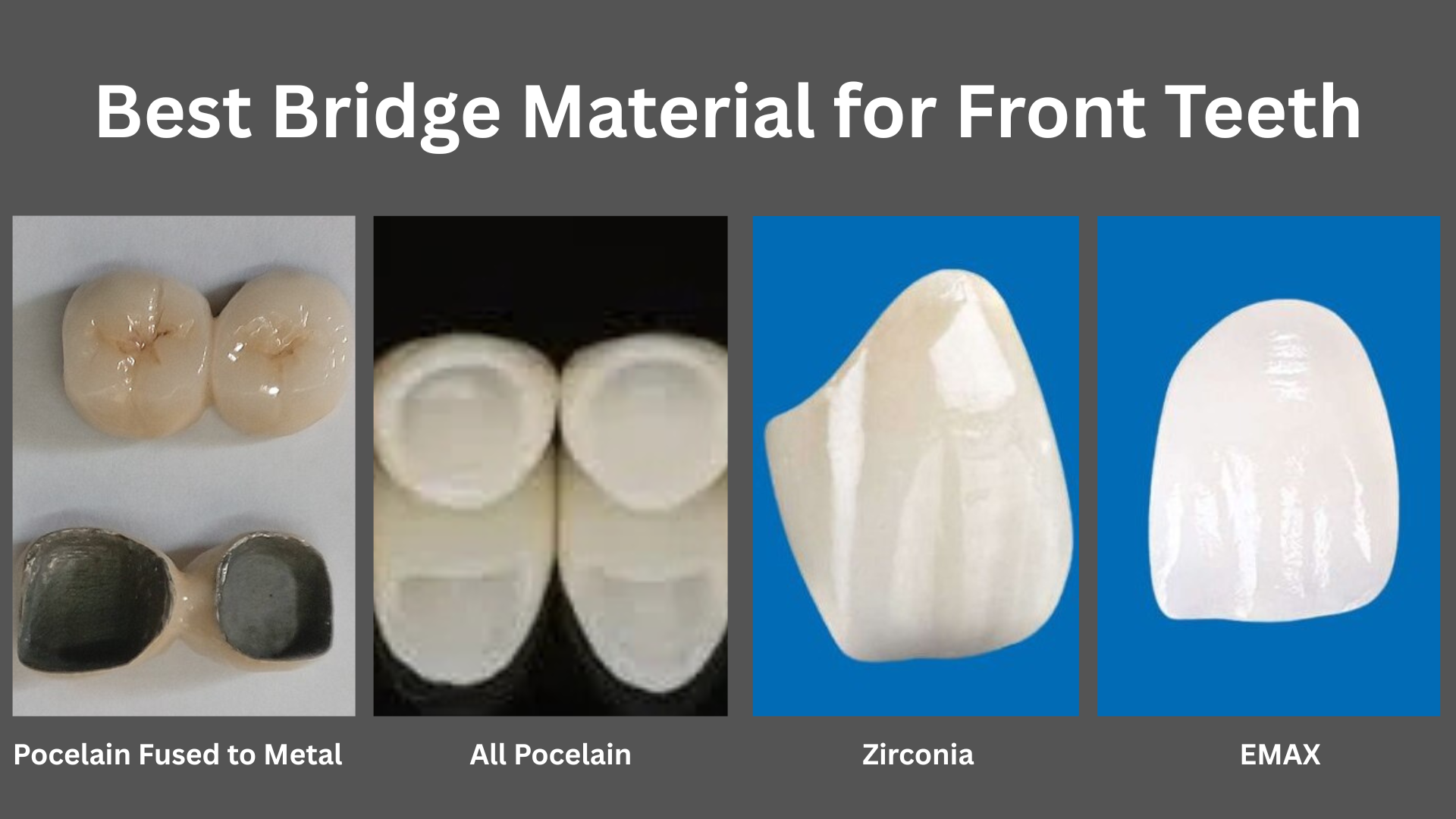
Best Bridge Material for Front Teeth
Introduction
When it comes to replacing missing front teeth, dental bridges are a popular solution for restoring function and aesthetics. However, choosing the best bridge material for front teeth is crucial. Unlike back teeth, front teeth are more visible, and any dental restoration must offer a balance of natural appearance, strength, and biocompatibility.
In this article, we’ll explore the best materials used in dental bridges for front teeth, comparing their pros and cons. We’ll also cover cost factors, durability, aesthetics, long-term outcomes, and care tips—so you won’t need another article on this topic.
Why Bridge Material Matters for Front Teeth
Front teeth are critical for:
- Smiling and facial aesthetics
- Speech clarity
- Biting into food (though not heavy chewing)
- Self-confidence and social interaction
Hence, the material must look natural and function properly without compromising comfort or strength.
Key Factors to Consider When Choosing Bridge Material
| Factor | Importance |
| Aesthetic quality | Very high for front teeth |
| Strength & durability | Moderate (not for heavy chewing) |
| Biocompatibility | Should not cause allergies or gum irritation |
| Cost | Should match patient’s budget |
| Longevity | Should last for 10+ years with good care |
Top Bridge Materials for Front Teeth (With Pros & Cons)
- Porcelain-Fused-to-Metal (PFM) Bridges
Description: A metal framework covered with tooth-colored porcelain.
Pros:
- Good strength with metal substructure
- Natural appearance (better than metal)
- Cost-effective compared to zirconia
Cons:
- Can show a dark line near the gums
- Porcelain may chip over time
- Less aesthetic than all-ceramic options
Ideal for: Budget-conscious patients needing a balance between strength and esthetics.
- All-Porcelain (Ceramic) Bridges
Description: Made entirely from tooth-colored ceramic, such as feldspathic porcelain or lithium disilicate.
Pros:
- Excellent esthetics; blends seamlessly with natural teeth
- Metal-free (no dark lines)
- Biocompatible and gentle to gums
Cons:
- Less strong than metal-ceramic bridges
- Can chip or fracture under pressure
- Costlier than PFM
Ideal for: Patients prioritizing cosmetics, especially for central and lateral incisors.
- Zirconia Bridges (Monolithic or Layered)
Description: Made of strong, tooth-colored zirconium oxide, either monolithic (full solid) or layered with ceramic for a natural look.
Pros:
- High strength and durability
- Excellent esthetics (especially layered zirconia)
- Biocompatible and stain-resistant
- No metal – completely aesthetic
Cons:
- More expensive
- Harder to adjust and polish
- Requires CAD/CAM milling technology
Ideal for: Long-term, high-strength esthetic restorations in front teeth.
- Lithium Disilicate (e.max) Bridges
Description: Made from a glass-ceramic known for its exceptional esthetics and translucency.
Pros:
- Natural appearance with life-like translucency
- Suitable for minimal tooth preparation
- Can be bonded strongly to tooth structure
Cons:
- Not as strong as zirconia
- Limited to short-span bridges (1 or 2 units)
- Requires careful case selection
Ideal for: Short-span bridges for incisors or one missing front tooth.
Material Comparison Table
| Material | Esthetics | Strength | Longevity | Metal-Free | Cost |
| PFM | Good | High | High | ❌ | $$ |
| All-Porcelain | Excellent | Moderate | Moderate | ✅ | $$$ |
| Zirconia | Excellent | Very High | Very High | ✅ | $$$$ |
| Lithium Disilicate (e.max) | Excellent | Moderate | High | ✅ | $$$ |
Which Is the Best Bridge Material for Front Teeth?
✅ If your priority is AESTHETICS:
Go for Layered Zirconia or Lithium Disilicate (e.max)
✅ If you want STRENGTH and AESTHETICS:
Monolithic Zirconia is ideal
✅ If you need a BUDGET OPTION:
Choose Porcelain-Fused-to-Metal (PFM)
Cost Considerations (India and Globally)
| Material | Approx. Cost (India) | Approx. Cost (US) |
| PFM | ₹6,000–₹10,000 per unit | $500–$1,000 |
| All-Porcelain | ₹10,000–₹14,000 per unit | $1,000–$1,500 |
| Zirconia | ₹12,000–₹20,000 per unit | $1,200–$2,500 |
| e.max | ₹12,000–₹18,000 per unit | $1,500–$2,000 |
Maintenance Tips for Long-Lasting Front Teeth Bridges
- Use a soft toothbrush and non-abrasive toothpaste
- Floss under the pontic using a floss threader
- Use a water flosser for easier access
- Visit your dentist every 6 months
- Avoid biting hard items (ice, pens, fingernails)
Conclusion
Choosing the best bridge material for front teeth depends on your esthetic expectations, budget, oral condition, and functional needs. Zirconia and e.max are top choices for premium esthetics and strength, while PFM remains a durable, budget-friendly option.
Consult your dentist for customized planning based on your bite, smile line, and gum health.
Related Reads
Bridge vs Implant vs Denture: Which Tooth Replacement Option is Best?
Dental Bridge Problems: Causes, Symptoms, and Solutions
How to Clean Under Dental Bridge: Effective Techniques
10 FAQs (Not Covered Above)
- Is zirconia safe for front teeth bridges?
Yes, it is biocompatible and provides excellent strength and esthetics. - Can I whiten my bridge if it stains?
No, bridges do not respond to bleaching. They must be replaced or polished. - Which bridge looks most like natural teeth?
e.max or layered zirconia bridges offer the closest resemblance to natural enamel. - Are metal-free bridges stronger than PFM?
Yes, monolithic zirconia is stronger than PFM and more aesthetic. - Can I get a bridge for just one front tooth?
Yes, 3-unit bridges are common for replacing one missing front tooth. - Do bridges affect speech?
Initially, yes. But most people adapt within a few days. - Which is more costly: implant or bridge?
Implants are usually more expensive due to surgical and prosthetic components. - How long does a front tooth bridge last?
With proper care, 10–15 years or longer. - Are temporary bridges made from the same material?
No, temporary bridges are usually made from acrylic or composite resin. - Can food get stuck under the bridge?
Yes, proper cleaning using interdental brushes or floss threaders is essential.
